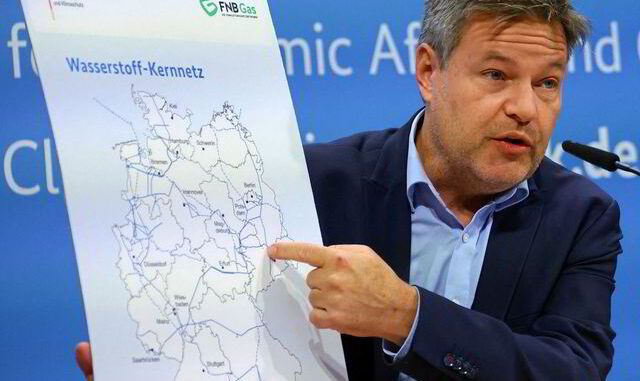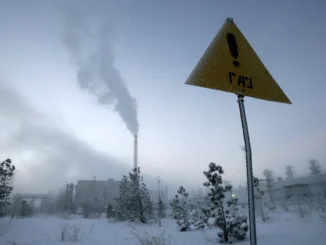
Extending Germany’s “core” hydrogen network beyond industrial customers to serve homes and small businesses could end up being hugely costly for end users — even before the actual cost of hydrogen is factored in, a new study backed by gas industry players has revealed.
And at least part of this significantly higher cost would be due to the need to amortise the residual, historic capital costs incurred from existing fossil gas pipelines that have been repurposed to carry hydrogen.
The report Estimation of future hydrogen network usage fees, published by the Institute of Energy Economics at the University of Cologne (EWI) yesterday (Tuesday), analyses the costs of rolling out Germany’s planned 9,700km core network of transmission pipelines to serve large industrial users, made up of existing gas pipelines and new H2 pipes, taken together with the additional costs of converting 80% of Germany’s existing gas distribution network (over 450,000km of pipes) to carry hydrogen.
It found that the weighted average fees across all customer groups in Germany would be around €0.018 ($0.0195) per kWh) by 2045, when adjusted for inflation — around 87% higher than users pay to use the existing gas network today.
Today, fees to use the gas network in Germany account for around 18% of customers’ bills, in addition to the cost of fuel, environmental levies and other taxes.
Small businesses could be expected to see the biggest customer-segment rise on H2 network fees on average, with fees rising by up to 126%, depending on the area being served.
Households would see rises of 83-88%, while industrial users would see the smallest increases — which still come in at around 49-74%.
And while Germany’s government has promised to subsidise the network fees associated with the core build-out when it comes on stream in 2037, it has made no such promises with regard to the distribution network — dealing a massive blow to gas distributors seeking to provide H2 for domestic heating.
The EWI figures, which are based on weighted average cost of capital (WACC — broadly, the cost of borrowing to finance the build-out) of 5.39-6.32%, become even starker when adjusted to reflect different interest-rate scenarios.
If interest rates rise by 2.25 percentage points, which is not inconceivable given recent economic turmoil across the globe, the cost of using the network would skyrocket by 120% on average, with households and small business seeing fee rises of up to 138% and 187% respectively.
On the other hand, if interest rates fall by 2.25 percentage points, the rise would be dampened. However, it would still yield an increase in fees of up to 40% on average.
Germany’s government has promised the private sector returns of 6.7% on equity associate with building out the core network.
Demand risk
Even more alarming for hydrogen network users is the impact of H2 demand on the cost of using the network.
The report used hydrogen demand assumptions made by gas and water trade association Deutscher Verein des Gasund Wasserfaches (DVGW), which commissioned the report and estimated H2 demand of 398TWh by 2045 — based on the use of hydrogen in space heating and transport.
But in the event of lower-than-expected demand — and fewer users — the cost burden would fall more heavily on those who did choose to connect, EWI warned.
“If demand in the building sector were lower than in the DVGW scenario… the hydrogen network tariffs of the remaining customers connected to the distribution grid would increase particularly sharply,” the research institute said.
This increase could be partially mitigated if portions of the distribution grid were not converted to carry hydrogen in response to poor demand, it added — but the transmission grid costs, which are already baked in as part of the core network planning, would remain.
UK consultancy Aurora Energy Research recently argued that Germany is already at risk of overbuilding its core hydrogen network, estimating that demand would only reach 73TWh by 2030.
In total, EWI estimates that it would cost €68.8bn to create the hydrogen network envisaged by DGVW, with the vast majority of this (€47bn) coming from the conversion of the distribution network.
This implies that the 9,700km core network would cost €21.8bn — €2bn more than the figure mooted by Germany’s economics and climate affairs minister Robert Habeck at the project’s launch in November last year.
Gas network amortisation
A key problem for both networks, and German regulators, is what to do with gas network residual values (ie, capital costs associated with building the original pipelines that are yet to be paid off) when gas pipes are shut down or converted to H2 as the country decarbonises.
German regulators have already decided that hydrogen customers using repurposed gas networks will be saddled with paying off residual values, in addition to the considerable capital costs associated with repurposing gas pipeline networks for H2 and building new hydrogen pipelines.
This is partly why the costs associated with extending the core network to the distribution pipes would be so high — DGVW envisages repurposing 80% of the existing gas network, compared to just 14% of the transmission network (which would be used for the core network).
However, EWI admits that there is a risk that residual values associated with the remaining 86% of the transmission network could be passed on to H2 customers by regulators, should it all be closed in future.



